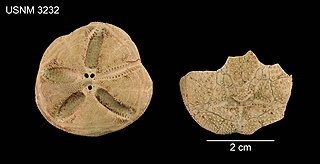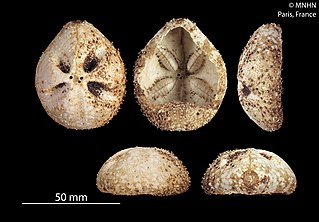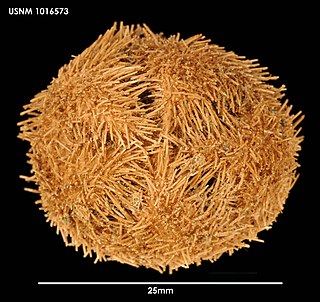
The Aspidodiadematidae are a family of sea urchins.

Diadema is a genus of sea urchins of the family Diadematidae.
The World Register of Marine Species (WoRMS) is a taxonomic database that aims to provide an authoritative and comprehensive list of names of marine organisms.

The Echinacea are a superorder of sea urchins. They are distinguished by the presence of a rigid test, with ten buccal plates around the mouth, and solid spines. Unlike some other sea urchins, they also possess gills. The group is a large one, with species found worldwide.

The Camarodonta are an order of globular sea urchins in the class Echinoidea. The fossil record shows that camarodonts have been in existence since the Lower Cretaceous.

Abatus cordatus is a species of sea urchin in the family Schizasteridae. It is native to shallow seas surrounding certain island groups in the southern Indian Ocean. The body is protected by a hard test or shell which is covered with spines. The female broods its young in deep pockets on the upper surface, retaining the young in place with specialised spines. American zoologist Addison Emery Verrill first scientifically described A. cordatus in 1876.

Abatus shackletoni is a species of sea urchin of the family Schizasteridae. Their armour is covered with spines. It is in the genus Abatus and lives in the sea. Abatus shackletoni was first scientifically described in 1911 by Koehler.

Agassizia scrobiculata is a species of sea urchin of the family Prenasteridae.

Amphipneustes davidi is a species of sea urchin of the family Temnopleuridae. Their armour is covered with spines. It is placed in the genus Amphipneustes and lives in the sea. Amphipneustes davidi was first scientifically described in 2010 by Madon-Senez.

Amphipneustes koehleri is a species of sea urchin of the family Temnopleuridae. Their armour is covered with spines. It is placed in the genus Amphipneustes and lives in the sea. Amphipneustes koehleri was first scientifically described in 1905 by Ole Mortensen.

Araeolampas atlantica is a species of sea urchin of the family Loveniidae. Their armour is covered with spines. It is placed in the genus Arachnoides and lives in the sea. Araeolampas atlantica was first scientifically described in 1974 by K. Serafy.

Araeosoma thetidis is a species of sea urchin of the family Echinothuriidae. This species can be found in deep sea off Australia and New Zealand. A. thetidis was first scientifically described in 1909 by Hubert Lyman Clark.

Echinometra is a genus of sea urchins in the family Echinometridae.
Austrocidaris canaliculata is a species of sea urchins of the family Cidaridae. Their armour is covered with spines. Austrocidaris canaliculata was first scientifically described in 1863 by Alexander Agassiz.

Austrocidaris spinulosa is a species of sea urchins of the family Cidaridae. Their armour is covered with spines. Austrocidaris spinulosa was first scientifically described in 1910 by Ole Mortensen.
Breynia desorii is a species of sea urchins of the Family Loveniidae. Their armour is covered with spines. Breynia desorii was first scientifically described in 1851 by Gray.
Breynia neanika is a species of sea urchins of the Family Loveniidae. Their armour is covered with spines. Breynia neanika was first scientifically described in 1982 by McNamara.
Brisaster tasmanicus is a species of sea urchins of the Family Schizasteridae. Their armour is covered with spines. Brisaster tasmanicus was first scientifically described in 1974 by McKnight.
Caenopedina otagoensis is a species of sea urchins of the Family Pedinidae. Their armour is covered with spines. Caenopedina otagoensis was first scientifically described in 1968 by McKnight.
Austrocidaris is a genus of sea urchins belonging to the family Cidaridae.













